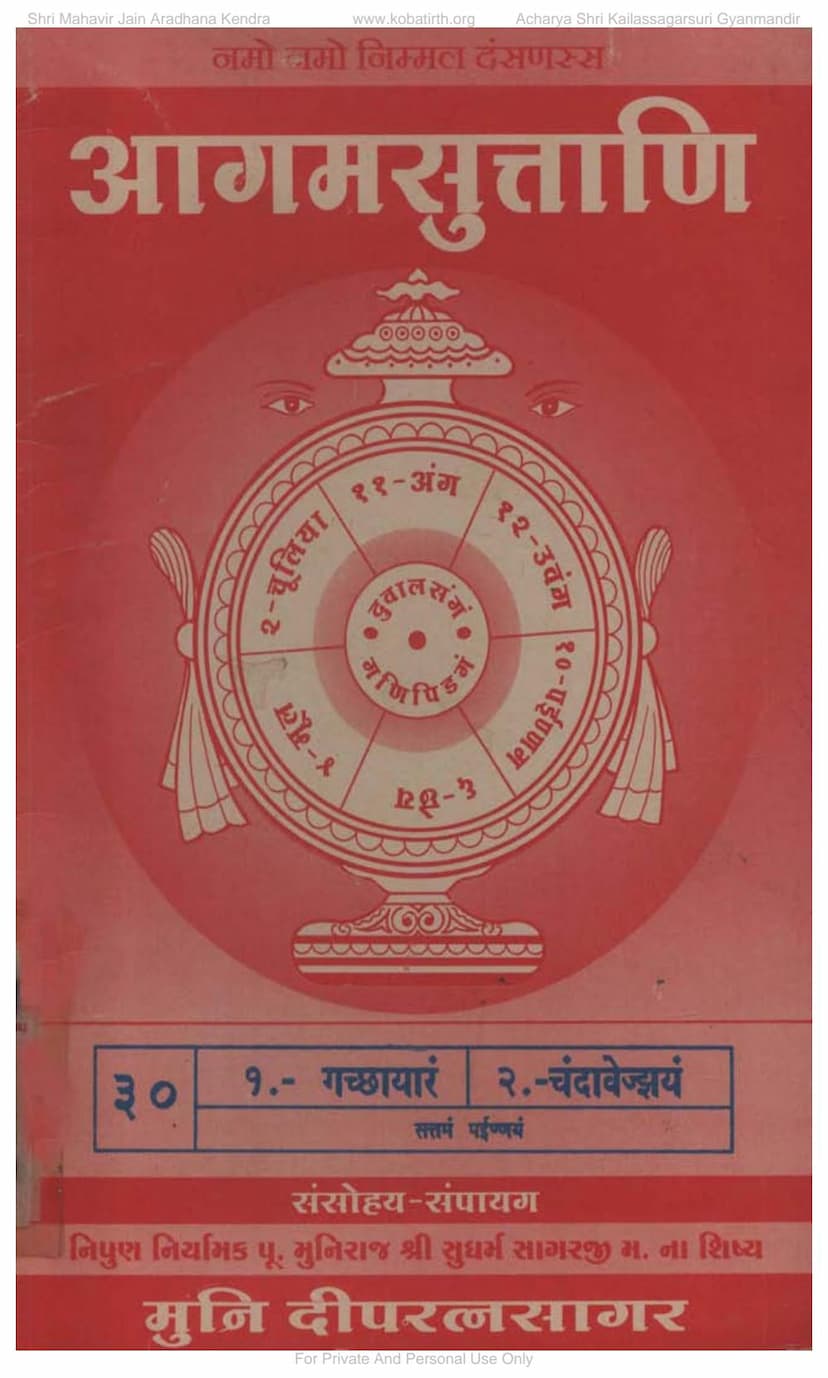Agam 30B Chandavezzayam Painnagsutt 07B Moolam
Added to library: September 1, 2025

Summary
This document is a detailed catalog or index for Agam 30B Chandavezzayam Painnagsutt 07B Moolam, a Jain religious text. Here's a comprehensive summary of the provided pages:
1. Identification and Publisher:
- Book Title: Agam 30B Chandavezzayam Painnagsutt 07B Moolam (This indicates it's the 7th Jain text in the Painnaya section, within the Agam Sutta category, specifically the 30th Agam, and within that, the 7th part/section of the Chandavezzayam).
- Author(s): Dipratnasagar, Deepratnasagar (likely referring to the compiler/editor of this edition).
- Publisher: Agam Shrut Prakashan.
- Website: www.kobatirth.org
- Organization: Shri Mahavir Jain Aradhana Kendra, Acharya Shri Kailassagarsuri Gyanmandir.
- Purpose: For Private And Personal Use Only.
2. Content and Structure: The text is a collection of Jain Agamas (scriptures). The table of contents on Page 6 outlines the structure of the Chandavezzayam text itself:
- Chapter 1-3: Mangal-Dar Nirupan (Description of auspicious days)
- Chapter 4-21: Vinaygun-varam (Virtue of humility/discipline)
- Chapter 22-36: Aairya-Daram (The Acarya/Teacher)
- Chapter 37-53: Seesa-Daram (The Disciple)
- Chapter 54-71: Vinay-Niggah-Daam (Discipline and self-control)
- Chapter 72-99: Naan-gun-Daram (Virtue of Knowledge)
- Chapter 100-116: Charan-gun-Daram (Virtue of Conduct)
- Chapter 117-172: Maran-gun-Daram (Virtue of Death/Dying)
- Chapter 174-175: Upsamhar (Conclusion)
3. Financial Support and Acknowledgements: A significant portion of the document (Pages 3-5, and Page 22) is dedicated to listing the donors and financial contributors for this publication. This highlights the community support behind making these Jain scriptures accessible.
- Many individuals, families, and Jain Sangh (associations) from various cities in India (Vadodara, Mumbai, Madras, Surendranagar, Ahmedabad, etc.) and even Los Angeles, USA, are listed as contributors.
- The contributions are often made in remembrance of family members, in honor of spiritual guides (Sadhvis/Munis), or for specific Jain festivals and observances.
- The main financial supporter mentioned is Smt. Nayana Ben Rameshchandra Shah and family (Vadodara).
4. Editorial Notes and Guidance:
- Page 7 provides important notes for readers:
- Numbering: Explains the various numbering systems used (consecutive scriptural/verse number, Hindi numbering for source, bracketed numbers for verses/songs, English numbers for commentary if available).
- Punctuation: Clarifies the use of vertical bars (|) for verses and double bars (||) for songs.
- Editorial Additions: Square brackets
[ ]indicate editorial additions or completions. - Note on Agama Equivalents: Discusses the relationship between "Galvar" and "Mantrayeva" (possibly referring to different versions or classifications of Agamas) and the rationale for presenting them as alternatives. It also mentions that commentaries for some texts might be missing.
5. Textual Content (Excerpts): Pages 8-17 present the actual Jain scriptural text in Prakrit and Apabhramsha languages, along with verse numbers (e.g., ||2||, ||3||, etc.). The content focuses on themes such as:
- Respect for Acaryas and Gurus: Emphasizes the importance of humility, respect, and learning from teachers (Pages 8-9).
- Qualities of a Good Disciple: Describes the virtues of a student, such as patience, contentment, humility, and adherence to teachings (Pages 10-13).
- The Importance of Knowledge (Gyan): Discusses how true knowledge is attained through study, understanding, and its application in conduct (Pages 11-12).
- The Significance of Conduct (Charitra): Highlights the role of righteous conduct, virtues, and self-control in spiritual progress and liberation (Pages 13-15).
- The Nature of Death and Spiritual Preparation (Maran): Details how to approach death with equanimity, having practiced spiritual disciplines, and the consequences of neglecting spiritual preparation (Pages 15-17).
- Overcoming Passions (Kashayas): Stresses the importance of controlling anger, pride, deceit, and greed for spiritual advancement.
6. Catalog of Other Publications: Pages 18-22 list other publications from the same publisher, "Agam Shrut Prakashan" and other related institutions. This section serves as a bibliography or catalog of Jain literature, including:
- Various "Abhinav" (new/modern) series of texts.
- Chaitra Vandan (temple worship) collections.
- Panchang (almanacs).
- Specific rituals and practices.
- The Agam Suttani (collection of Agam scriptures) from 1 to 45, with detailed listings of which part is published by whom (Agam Shrut Prakashan vs. Abhinav Shrut Prakashan).
- Specific mention of Agam Sutta 30B Chandavezzayam is found on page 20 as "Agam Suttaani-30-2".
7. Appendices (Parisiddh): Page 21 describes planned or existing appendices:
- Visayanukkami: Comprehensive index of subjects for Agamas 45-49.
- VisiShta Shabdanukkami: Glossary of special words, with references.
- Vishesh Namānukkami: Index of proper names appearing in the Agamas.
- Gāthānukkami: Index of verses (Gathas).
- Sūtrānukkami: Index of Sutras.
In essence, this document is a detailed presentation of a specific Jain scripture, "Chandavezzayam Painnagsutt," including its textual structure, editorial information, a strong emphasis on community financial support, and a broader catalog of related Jain scholarly works. The focus is on preserving and disseminating these ancient Jain texts.